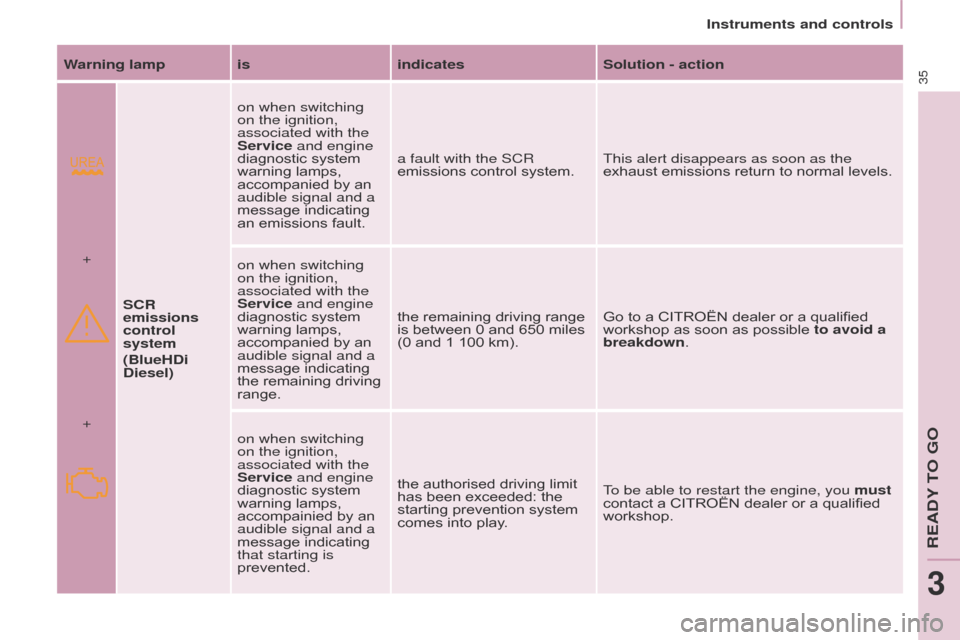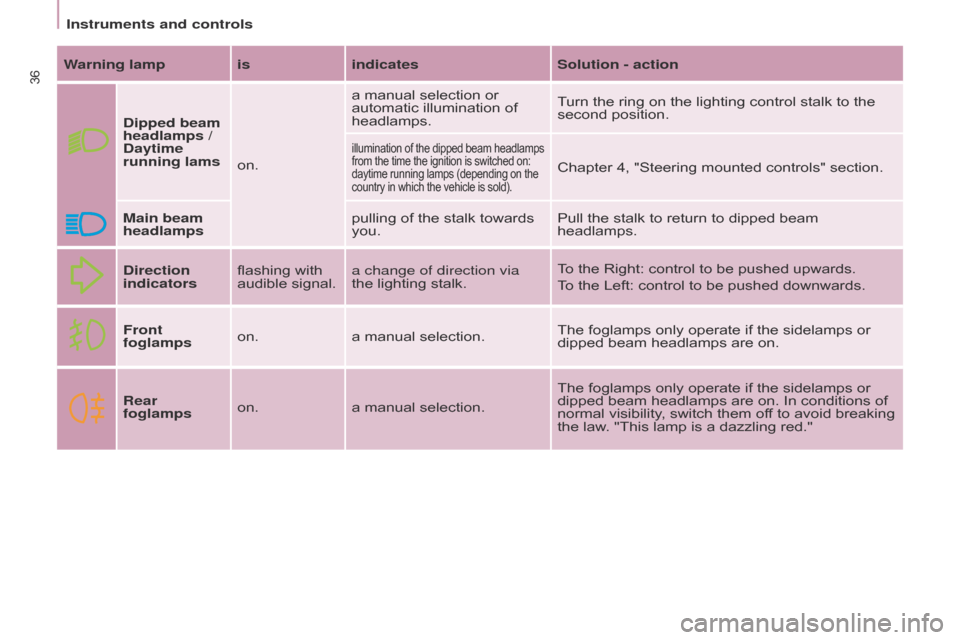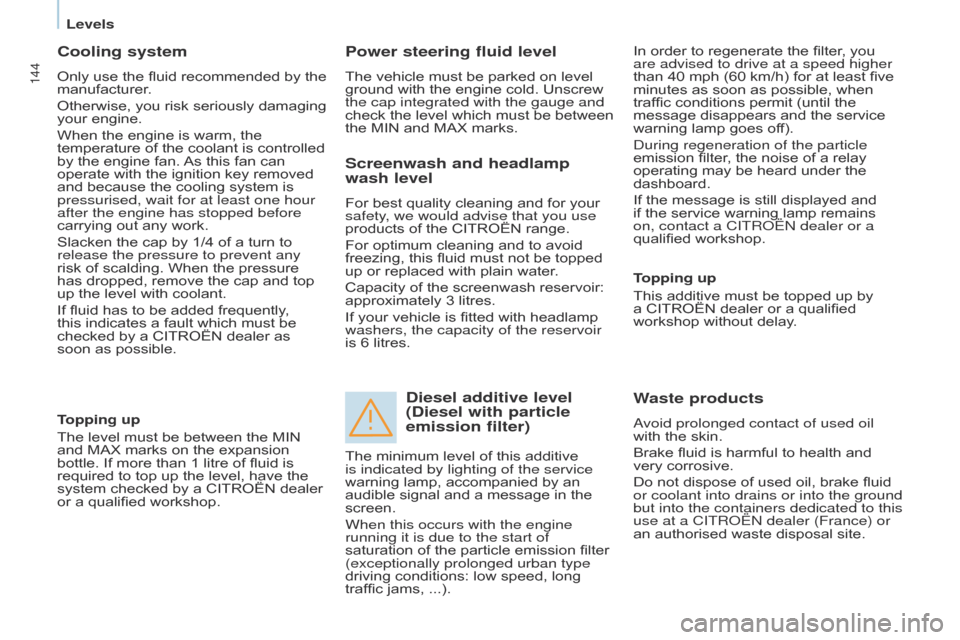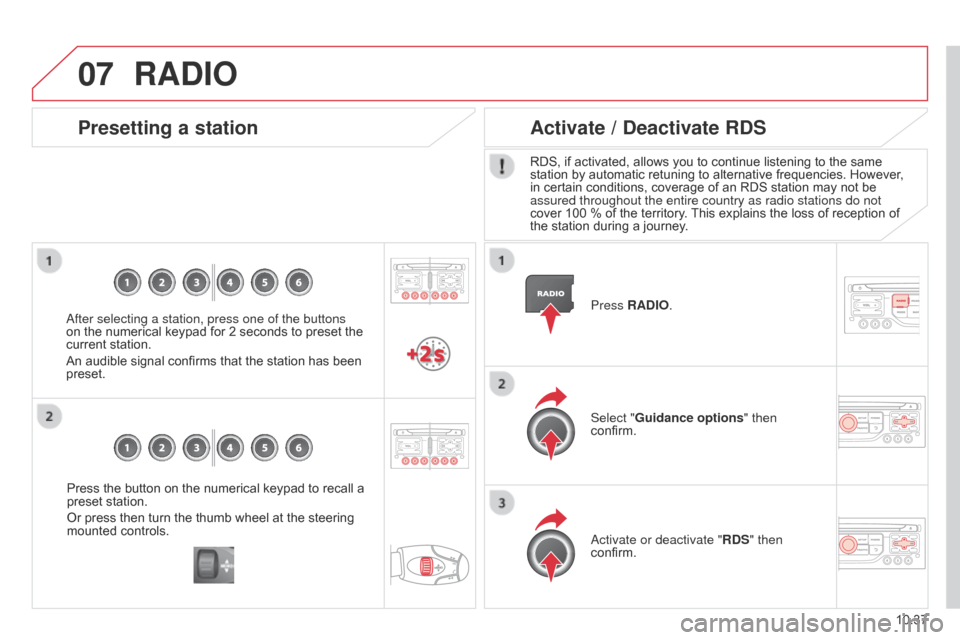turn signal Citroen BERLINGO MULTISPACE RHD 2015 2.G Owner's Manual
[x] Cancel search | Manufacturer: CITROEN, Model Year: 2015, Model line: BERLINGO MULTISPACE RHD, Model: Citroen BERLINGO MULTISPACE RHD 2015 2.GPages: 276, PDF Size: 12.21 MB
Page 37 of 276

Berlingo_2_VP_en_Chap03_Pret-a-partir_ed02-2014
35Warning lamp isindicatesSolution - action
S cr
emissions
control
system
(BlueH
d i
d
iesel) on when switching
on the ignition,
associated with the
Service
and engine
diagnostic
system
warning
lamps,
accompanied
by an
audible signal and a
message
indicating
an
emissions fault.a fault with the SCR
emissions
control system.This alert disappears as soon as the
exhaust
emissions return to normal levels.
+ on when switching
on the ignition,
associated with the
Service
and engine
diagnostic
system
warning
lamps,
accompanied
by an
audible signal and a
message
indicating
the
remaining driving
range.the
remaining driving range
is
between 0 and 650 miles
(0
and 1 100 km).Go
to a CITROËN dealer or a qualified
workshop
as soon as possible to avoid a
breakdown.
+ on when switching
on the ignition,
associated with the
Service
and engine
diagnostic
system
warning
lamps,
accompainied
by an
audible signal and a
message
indicating
that starting is
prevented.the
authorised driving limit
has
been exceeded: the
starting
prevention system
comes
into play.To be able to restart the engine, you must
contact
a CITROËN dealer or a qualified
workshop.
Instruments and controls
REadY To Go
3
Page 38 of 276

Berlingo_2_VP_en_Chap03_Pret-a-partir_ed02-2014
36Warning lamp isindicatesSolution - action
d
ipped beam
headlamps /
d
aytime
running lams on.a
manual selection or
automatic
illumination of
headlamps.T
urn the ring on the lighting control stalk to the
second
position.
illumination of the dipped beam headlamps from
the time the ignition is switched on: daytime
running lamps (depending on the
country
in which the vehicle is sold).
Chapter 4, "Steering mounted controls" section.
Main beam
headlamps pullin
g
of
the
stalk
towards
you. Pull
the stalk to return to dipped beam
headlamps.
d
irection
indicators flashing
with
audible
signal. a change of direction via
the
lighting
stalk. To
the Right: control to be pushed upwards.
To
the Left: control to be pushed downwards.
Front
foglamps on.
a
manual
selection. The
foglamps only operate if the sidelamps or
dipped
beam headlamps are on.
r
ear
foglamps on.
a
manual
selection. The
foglamps only operate if the sidelamps or
dipped
beam headlamps are on. In conditions of
normal
visibility, switch them off to avoid breaking
the
law. "This lamp is a dazzling red."
Instruments and controls
Page 64 of 276

62
Berlingo_2_VP_en_Chap04_Ergonomie_ed02-2014
Exceeding the programmed
speed
Pressing the accelerator pedal in order
to exceed the programmed speed
will have no ef
fect unless you press
the pedal firmly beyond the point of
resistance.
The
limiter is deactivated temporarily
and
the programmed speed flashes
accompanied
by an audible signal.
To
return to the limiter function, reduce
your
speed to below the programmed
speed.
Switching the function off
- Place the switch in position 0 or
switch off the ignition to switch the
system
off.
The
last programmed speed remains in
the
memory.
Operating fault
The programmed speed is cleared then replaced by three dashes.
Contact a CITR
o Ë n dealer or a
qualified
workshop to have the system
checked.
Good practice
Flashing of the speed
The speed flashes:
-
following forcing of the accelerator
point of resistance,
-
when
the limiter cannot prevent an
increase in the vehicle speed due
to
the profile of the road or on a
steep descent,
-
in
the event of sharp acceleration. In
any event, the speed limiter cannot
replace the need to observe speed
limits,
nor can it replace the need for
vigilance
on the part of the driver.
Always pay attention to the profile
of the road and sharp acceleration
and
stay in complete control of your vehicle.
T
o avoid any jamming under the
pedals:
-
ensure
that the mat and its fixings
on
the floor are positioned correctly,
-
never
place one mat on top of
another
.
Steering mounted controls
Page 112 of 276

11 0
Berlingo_2_VP_en_Chap05_Securite_ed02-2014
AntI-SLIP rEGuLAtIO n (AS r )
A nd d Y n AMI c S t
ABILI
t Y
c
O ntr OL ( d S c )
These systems are linked and complement the ABS.
The
ASR
system is very useful for
maintaining
optimum drive and
avoiding losses of control of the vehicle
on
acceleration.
The
system optimises drive to prevent
the
wheels skidding, by acting on the
brakes
of the drive wheels and on the
engine.
It also allows the directional
stability
of the vehicle to be improved
on
acceleration.
Use the
d SC to hold your course
without
attempting to countersteer.
If there is a variation between the
trajectory
followed by the vehicle and
that
required by the driver, the DSC
system
automatically acts on the
engine
and the brake of one or more
wheels,
in order to put the vehicle back
on
course.
deactivation
In certain exceptional conditions
(starting the vehicle when stuck in mud
or
snow, or on loose ground...), it could
prove useful to deactivate the a
SR and
DSC
systems to make the wheels spin
and
regain grip.
Operating fault
Good practice
The ASR/DSC systems offer increased safety
during normal driving, but
should
not incite the driver to take risks
or
to drive at high speed.
The
operation of these systems is
ensured
if the recommendations
of
the manufacturer regarding
the
wheels (tyres and rims), the
braking
components, the electronic
components
and the fitting and repair
procedures
are observed.
After
an impact, have these systems
checked
by a CITROËN dealer or a
qualified
workshop.
Operation
The warning lamp flashes when operation of the a SR or
DSC
is triggered.
t
hey engage again:
-
automatically
above 30 mph
(50
km/h), When
a malfunction of the systems
occurs, the warning
lamp
and the LED come on,
accompanied
by an audible
signal
and a message in the
screen.
-
Press the button or turn
the dial to the
d SC o FF
position (depending on
model).
-
The
LED comes on: the
ASR
and
DSC
systems no longer come into
play
. -
manually
by pressing the
button again or by turning
the dial to this position
(depending
on model).Contact a CITR
o Ë n dealer or a
qualified
workshop to have the system
checked.
The
warning lamp may also come on if
the
tyres are under-inflated. Check the
pressure
of each tyre.
driving safely
Page 121 of 276

119
Berlingo_2_VP_en_Chap05_Securite_ed02-2014
Front airbags
The front airbags are fitted in the centre of the steering wheel for the
driver and in the dashboard for the
front passenger.
d
eployment
They are deployed, except the
passenger's front airbag if it has been
deactivated, in the event of a serious
front
impact applied to all or part of the
front
impact zone A in the longitudinal
centreline of the vehicle on a horizontal
plane
directed from the front towards
the
rear of the vehicle.
The
front airbag inflates between the
front occupant of the vehicle and the
dashboard to cushion their forward
movement.
d
eactivationo
nly the passenger's front airbag can
be deactivated:
-
with the ignition switched off
,
insert
the key into the passenger's
front airbag deactivation switch,
-
turn it to the of
f "OFF" position,
-
then
remove the key, keeping the
switch
in the new position.
The passenger's front
airbag
warning lamp in the
instrument
panel is on while
the
airbag is deactivated.If
the two airbag warning lamps
are on continuously
, do not install
a rear-facing child seat, contact
a
CITROËN dealer or a qualified
workshop.
Front airbag fault
T
o ensure the safety of your child,
it is essential to deactivate the
passenger's front airbag when you
install a rear-facing child seat on the
front
passenger seat. Otherwise, the
child
would
risk
being
kille
d
or
seriously
injured
if the airbag were to inflate.
r
eactivation
In the "OFF" position, the passenger's
front airbag will not be deployed in the
event of an impact.
As soon as the child seat is removed,
turn the airbag switch to the
"O n "
position to re-activate the passenger's
front airbag and so ensure the safety
of your passenger in the event of an
impact.
If this warning lamp comes on,
accompanied by an
audible
signal and a message
in the screen, contact a
CITR
o Ë n dealer or a
qualified
workshop to have
the
system checked.
airbags
SaFETY
5
Page 146 of 276

Berlingo_2_VP_en_Chap07_Verification_ed02-2014
144
cooling system
Only use the fluid recommended by the manufacturer.
Otherwise,
you risk seriously damaging
your
engine.
When
the engine is warm, the
temperature
of the coolant is controlled
by
the engine fan.
As
this fan can
operate
with the ignition key removed
and
because the cooling system is
pressurised, wait for at least one hour
after the engine has stopped before
carrying
out any work.
Slacken
the cap by 1/4 of a turn to
release the pressure to prevent any
risk
of scalding. When the pressure
has
dropped, remove the cap and top
up
the level with coolant.
If
fluid has to be added frequently,
this
indicates a fault which must be
checked
by a CITROËN dealer as
soon
as possible.
Power steering fluid level
The vehicle must be parked on level ground with the engine cold. Unscrew
the cap integrated with the gauge and
check
the level which must be between
the
MIN and MAX marks. In
order to regenerate the filter, you are advised to drive at a speed higher
than
40 mph (60 km/h) for at least five minutes
as soon as possible, when
traffic
conditions permit (until the
message
disappears and the service
warning
lamp goes off).
d
uring regeneration of the particle
emission
filter, the noise of a relay
operating
may be heard under the
dashboard.
If
the message is still displayed and
if
the service warning lamp remains
on, contact a CITR
o Ë n dealer or a
qualified
workshop.
topping up
The
level
must
be
between
the
MIN
and
MAX
marks
on
the
expansion
bottle.
If
more
than
1
litre
of
fluid
is
required
to
top
up
the
level,
have
the
system
checked
by
a
CITROËN
dealer
or
a
qualified
workshop.
Screenwash and headlamp
wash level
For best quality cleaning and for your safety , we would advise that you use
products
of the CITROËN range.
For
optimum cleaning and to avoid
freezing,
this fluid must not be topped
up
or replaced with plain water.
Capacity
of the screenwash reservoir:
approximately
3 litres.
If
your vehicle is fitted with headlamp
washers, the capacity of the reservoir
is
6 litres.
diesel additive level
( d iesel with particle
emission filter)
topping up
This additive must be topped up by
a
CITROËN dealer or a qualified
workshop
without delay.
Waste products
avoid prolonged contact of used oil
with the skin.
Brake
fluid is harmful to health and
very
corrosive.
Do
not dispose of used oil, brake fluid
or coolant into drains or into the ground
but into the containers dedicated to this
use at a CITR
o Ë n dealer (France) or
an
authorised waste disposal site.
The
minimum
level
of
this
additive
is indicated by lighting of the service
warning
lamp,
accompanied
by
an
audible
signal
and
a
message
in
the
screen.
When this occurs with the engine
running it is due to the start of
saturation
of
the
particle
emission
filter
(exceptionally prolonged urban type
driving
conditions:
low
speed,
long
traffic
jams,
...).
Levels
Page 154 of 276

Berlingo_2_VP_en_Chap07_Verification_ed02-2014
152
In the event of a fault with
the the Scr emissions control
system
When switching on the ignition, the
URE
a , SERVICE and diagnostic
warning
lamps comes on, accompanied
by an audible signal and the display of
a
message "Emissions fault" to signal a
fault
with the emissions control system.
If
it is a temporary fault, the alert
disappears once the exhaust gas
emissions
return to normal.during an authorised driving phase (between
650 miles and 0 miles) (1 100 km and 0 km)
A system that prevents engine starting
is activated automatically
from
650 miles (1 100 km) after
confirmation
of a fault with the SCR
emissions
control system. Have the
system
checked by a CITROËN dealer
or
a
qualified workshop as soon as
possible. In the event of the detection
of a fault
If a fault with the SCR system is
confirmed
(after 30 miles (50 km)
covered
with the permanent display of
the
message signalling a fault), when
switching on the ignition, the SER
VICE
and
engine diagnostic warning lamps
come
on and the UREA
warning lamp
flashes,
accompanied by an audible
signal
and the display of a message
(e.g.:
"Emissions fault: Starting
prevented
in 150 miles") indicating the
remaining
range express in miles or
kilometres.
While
driving, the message is
displayed every 30 seconds while the
fault
with the SCR system persists.
You should go to a CITR
o Ë n dealer
or
a qualified workshop as soon as
possible.
o
therwise, you will not be able to
restart
your engine.
adBlue® additive
Page 158 of 276

Berlingo_2_VP_en_Chap07_Verification_ed02-2014
156
- obtain a bottle of adBlue®. After first
checking
the
use-by
date,
read carefully the instructions on
use on the label before pouring
the contents of the bottle into your
vehicle's
a
dBlue
® tank.
Important
:
if
your vehicle's
a
dBlue
® tank is completely
empty
-
which is confirmed by the alert
messages and the impossibility
of
starting
the engine, you must add at
least
3.8
litres (so two 1.89 litre bottles). -
After
emptying the bottle, wipe
away
any spillage around the tank
filler
using a damp cloth.
If any additive is split or splashed,
wash immediately with cold water
or
wipe with a damp cloth.
If the additive has crystallised, clean it
off using a sponge and hot water.
-
Refit
the blue cap to the tank and
turn
it a 6
th of a turn clockwise, to its stop.
-
Close
the
filler flap.
n
ever dispose of
a
dBlue
® additive
bottles
in
the
household
waste.
Place
them
in
a
special
container
provided
this
purpose
or
take
them to
your
dealer.
Important:
in the event of a top-
up after a breakdown because
of a lack of additive, signalled
by
the
message
"Top
up
emissions
additive:
Starting
prevented",
you must
wait
around
5
minutes
before
switching
on the ignition,
without opening the
driver's door, locking the vehicle or
introducing the key into the ignition
switch.
Switch on the ignition, then, after
10
seconds,
start
the
engine.
adBlue® additive
Page 227 of 276

07
10.37
Berlingo_2_VP_en_Chap10b_RT6-2-8_ed02-2014
Press the button on the numerical keypad to recall a preset station.
Or
press then turn the thumb wheel at the steering
mounted
controls.
Presetting a station
after selecting a station, press one of the buttons
on the numerical keypad for 2 seconds to preset the
current
station.
An
audible signal confirms that the station has been
preset. Press
r A d IO.
Activate / d
eactivate rd S
RDS, if activated, allows you to continue listening to the same station
by automatic retuning to alternative frequencies. However,
in
certain conditions, coverage of an RDS station may not be
assured throughout the entire country as radio stations do not
cover
100 % of the territory.
This
explains the loss of reception of
the
station during a journey.
Select "Guidance options " then
confirm.
a
ctivate or deactivate " rd S" then
confirm.
rAdIO